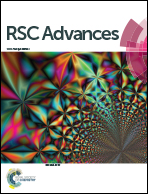Plasma oxidation of electrospun carbon nanofibers as supercapacitor electrodes†
Abstract
The effect of oxygen-plasma treatment on the capacitive behavior of electrospun carbon nanofibers is investigated. The plasma-modified fibers are enriched in oxygen functionalities, resulting in increased fiber wettability. Moreover, the plasma-treated nanofibers exhibit a specific capacitance of 377.0 F g−1, which is more than twice that of the nontreated nanofibers.


 Please wait while we load your content...
Please wait while we load your content...